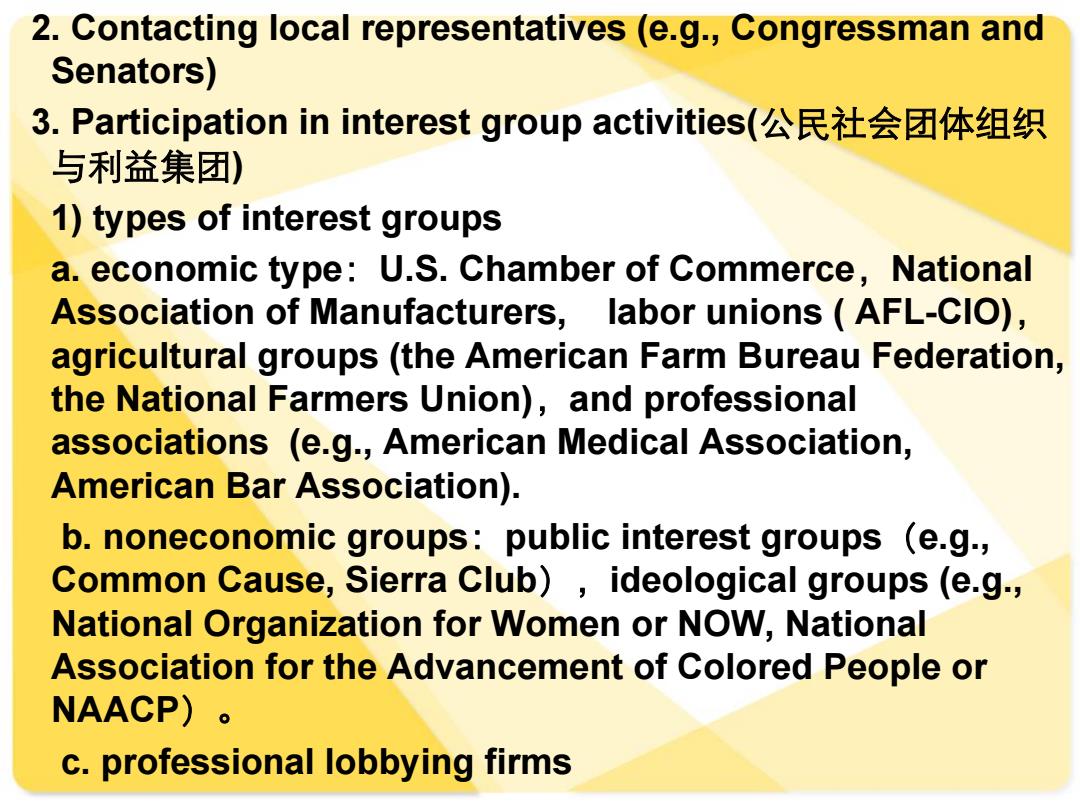
Public Participation in the Policy-Making Process in the United States
Public Participation in the Policy-Making Process in the United States

l.Introduction 直接民主与代议制民主的区别。如果是代议制民 主,为什么公众还要参与公共政策制定?主要是 利益的反映,希望能影响公共政策的制定。公众 参与是自然的和必然的,不参与是不自然的。但 公众参与的程度有不同,要看是议题是什么?是 否与自己有关?“事不关己,高高挂起”是多数 人对公共政策的态度。而且,公众参与的程度与 他们所在国家的体制有重大关系。在民主体制中, 公众参与的程度要高,而在非民主体制中,公众 参与的程度要低。美国宪法的头三个字是“We the People
I. Introduction 直接民主与代议制民主的区别。如果是代议制民 主,为什么公众还要参与公共政策制定?主要是 利益的反映,希望能影响公共政策的制定。公众 参与是自然的和必然的,不参与是不自然的。但 公众参与的程度有不同,要看是议题是什么?是 否与自己有关?“事不关己,高高挂起”是多数 人对公共政策的态度。而且,公众参与的程度与 他们所在国家的体制有重大关系。在民主体制中, 公众参与的程度要高,而在非民主体制中,公众 参与的程度要低。美国宪法的头三个字是“We the People”

Il.Means of the American Public in Participating in Public Policy-making in the U.S. 1.Voting in elections:Voting is a major form of political participation in democracies.It is also a major way for the public to change public policies by changing government officials. 1).suffrage (the right to vote):When the U.S.was founded,only white property owners had the right to vote.It wasn't until the 1820s that a majority of states had extended suffrage to propertyless white males. Black Americans got the right to vote theoretically after the Civil War.But Blacks faced many obstacles in the South.They were fully given the right to vote
II. Means of the American Public in Participating in Public Policy-making in the U.S. 1. Voting in elections: Voting is a major form of political participation in democracies. It is also a major way for the public to change public policies by changing government officials. 1). suffrage (the right to vote): When the U.S. was founded, only white property owners had the right to vote. It wasn't until the 1820s that a majority of states had extended suffrage to propertyless white males. Black Americans got the right to vote theoretically after the Civil War. But Blacks faced many obstacles in the South. They were fully given the right to vote

after the Voting Rights Act of 1965.Women were given the right to vote in 1920.Now every U.S.citizen over 18 years old has the right to vote,except that most states forbid criminals to vote while in prison. 2).voter turnout in the U.S.:Since 1920 the level of turnout in presidential elections has never exceeded 63%.Turnout is even lower in nonpresidential elections. Why?objective factors(客观因素):a.lack of party differentiation b.nobody can change the system fundamentally c.registration obstacle d.elections held on a weekday e.frequency of elections subjective factors(主观因素):a.sense of civic duty b.degree of interest c.age d.socioeconomic status
after the Voting Rights Act of 1965. Women were given the right to vote in 1920. Now every U.S. citizen over 18 years old has the right to vote, except that most states forbid criminals to vote while in prison. 2). voter turnout in the U.S.: Since 1920 the level of turnout in presidential elections has never exceeded 63%. Turnout is even lower in nonpresidential elections. Why? objective factors(客观因素): a. lack of party differentiation b. nobody can change the system fundamentally c. registration obstacle d. elections held on a weekday e. frequency of elections subjective factors(主观因素): a. sense of civic duty b. degree of interest c. age d. socioeconomic status

2.Contacting local representatives (e.g.,Congressman and Senators) 3.Participation in interest group activities(公民社会团体组织 与利益集团) 1)types of interest groups a.economic type:U.S.Chamber of Commerce,National Association of Manufacturers,labor unions (AFL-CIO), agricultural groups(the American Farm Bureau Federation, the National Farmers Union),and professional associations (e.g.,American Medical Association, American Bar Association). b.noneconomic groups:public interest groups (e.g., Common Cause,Sierra Club),ideological groups(e.g., National Organization for Women or NOW,National Association for the Advancement of Colored People or NAACP). c.professional lobbying firms
2. Contacting local representatives (e.g., Congressman and Senators) 3. Participation in interest group activities(公民社会团体组织 与利益集团) 1) types of interest groups a. economic type:U.S. Chamber of Commerce,National Association of Manufacturers, labor unions ( AFL-CIO), agricultural groups (the American Farm Bureau Federation, the National Farmers Union),and professional associations (e.g., American Medical Association, American Bar Association). b. noneconomic groups:public interest groups(e.g., Common Cause, Sierra Club),ideological groups (e.g., National Organization for Women or NOW, National Association for the Advancement of Colored People or NAACP)。 c. professional lobbying firms

2)what makes interest groups powerful and effective? a.organization b.size c.money 3)do interest groups corrupt American politics?the economic bias of the group system:some groups are more powerful than the other. 4.Public opinion 1)public opinion and democracy:Public opinion has an important place in democratic societies because of the concept that government springs from the will of the people.The policies of the U.S.government cannot be understood apart from public opinions;at the same time, public opinion is not a precise determinant of public policies
2) what makes interest groups powerful and effective? a. organization b. size c. money 3) do interest groups corrupt American politics? the economic bias of the group system: some groups are more powerful than the other. 4. Public opinion 1) public opinion and democracy: Public opinion has an important place in democratic societies because of the concept that government springs from the will of the people. The policies of the U.S. government cannot be understood apart from public opinions; at the same time, public opinion is not a precise determinant of public policies

民意与民主政治:二者几乎是同时产生的。民主就是 老百姓自己管理自己。那当然他们要以自己的意愿去 管理自己。民主政治如果没有民意作为基础,就不是 民主政治。二者的关系有几个假设: a.公众对政治或政府感兴趣; b.公众对公共事务有所了解; c.公众知道他们想要什么; d.公众,或者多数公众基本上是理性的(人或者人的判 断到底值不值得信赖) e.公众知道如何表达自己; 「.公众的意愿会得到政府重视,能够影响到政府的决 策

2)the nature of public opinion The difference between public opinion and popular opinion:the former refers to the enduring and fundamental beliefs that citizens share as members of an ongoing political community,while the latter is defined as the transitory thoughts that citizens have about topical events. a.民意不是一个人,或几个人,或少数人的意见;是 多数人的意见,但不一定是所有人的意见。 b.变化中的民意或民意的不稳定性,“民意如流水” c.民意有错的时候(从历史上看) d.民意有可能被操纵
2) the nature of public opinion The difference between public opinion and popular opinion: the former refers to the enduring and fundamental beliefs that citizens share as members of an ongoing political community, while the latter is defined as the transitory thoughts that citizens have about topical events. a

3)如何防止民意使民主发展成民粹 民粹主义(或平民主义)是一个反对精英,甚至政府 机构,一切以平民利益为主,平民参与政治的一种主 张。如拉丁美洲的一些国家在50-60年代;毛的文化 大革命,等等。民粹主义与民主政治的最大区别是: a.民主政治尊重民意,但不是所有事情,每一个决定 都要看是否有大多数人的支持; b.民主政治还是要讲究程序; c.民主政治一般是代议制民主,政治家有时需要勇气 去采用一些违法民意,但对人民长期利益有利的政策 领导者还是要领导(leaders have to lead).所以在民 主国家领导与尊重民意要协调

4)Scientific polling of public opinions: a.民意调查的历史:现代的科学民意调查产生于1920 年代的美国。在这之前,已经有对选举候选人之间谁 会当选做调查和预测的研究和办法。最早(1824年的 美国总统大选)是问记者,谁会赢?1924年开始对老 百姓做大范围的调查。1936年的调查严重失误。预测 共和党的Landon会赢,但结果是罗斯福以60%的得票 率当上美国总统。为什么预测失败?因为调查的对象 是有车的和有电话的。大选的结果是对选前民意调查 只好印证
4) Scientific polling of public opinions: